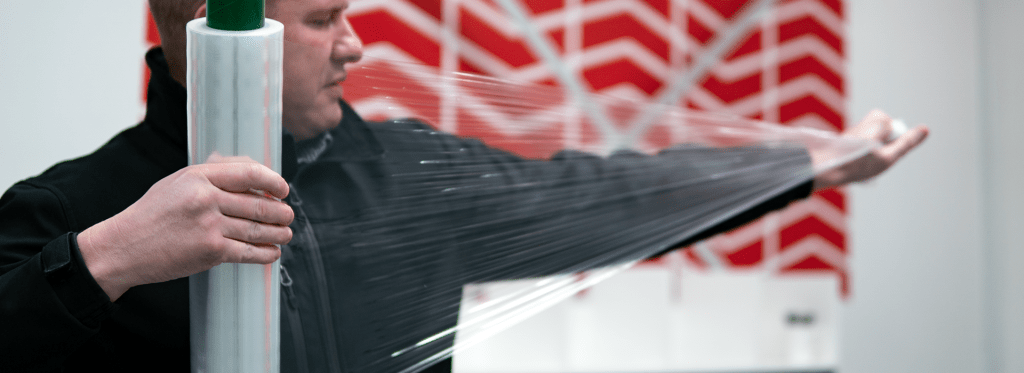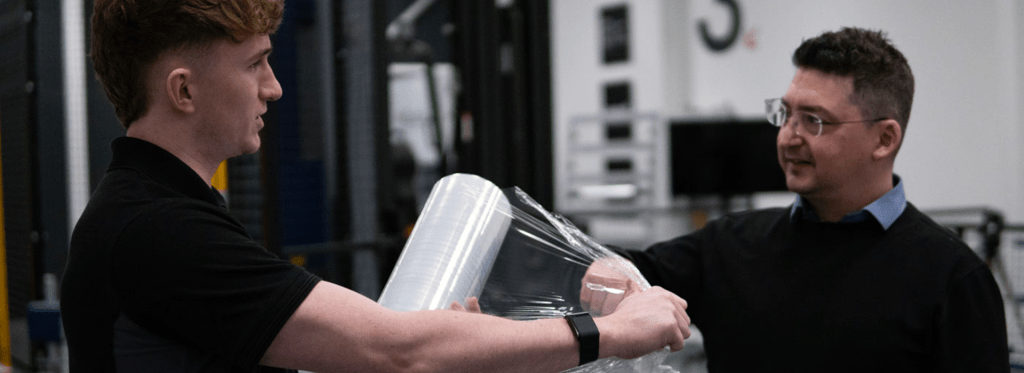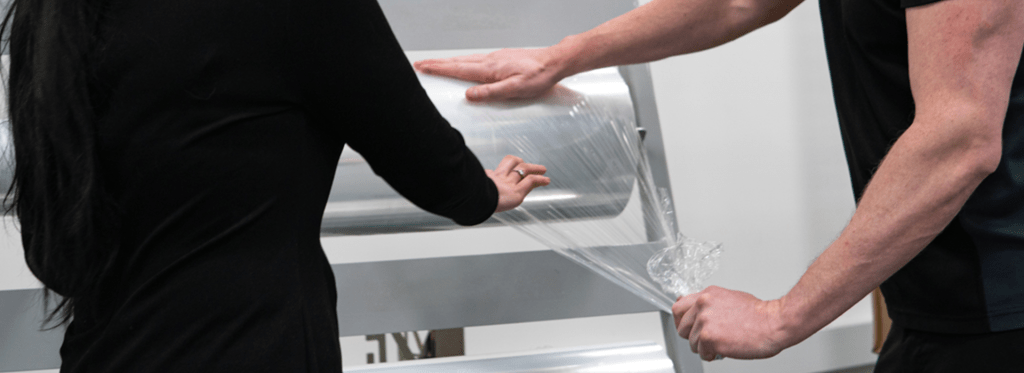
Back to blog
HOW TO FIND THE RIGHT PALLET WRAP FOR YOUR WAREHOUSE

Written by
BEN THOMPSON
Load Stability
Table of Contents
Estimated read time: 22 mins
INTRODUCTION
For the busy warehouse worker, pallet wrap is a vital tool in the arsenal to secure shipments and maintain a safe, efficient working environment. But as many who have worked in that role will know, having the wrong wrap can be an absolute nightmare that causes endless headaches and produces a sub-standard way of working.
In this article, we’ll breakdown everything your warehouse needs to consider when choosing the right film, so that you can guarantee the stability of your loads and instil confidence in your workforce…

UNDERSTANDING LOAD STABILITY
Why Load Stability Matters
When we talk about “load stability,” we mean how well goods stay put once they’re wrapped and transported. A stable load is less likely to shift in transit, reducing the risk of product damage and, importantly, preventing accidents on the road or in the warehouse. If your wrapped pallets are frequently toppling over or arriving damaged, it’s usually a red flag that the wrong type of film is being used—or that it’s being applied incorrectly.
Common Pitfalls
Unstable loads can lead to all sorts of headaches:
Product damage: Goods that shift or topple can tear, break, or be squashed, all of which affects your bottom line.
Injuries: In warehouses, falling pallets or unsecured loads increase the risk of accidents and injuries to staff.
Insurance and liability concerns: Damages or accidents involving unstable loads can bring about legal disputes, higher insurance premiums, and damage to reputation.
The right pallet wrap can help you avoid these pitfalls by offering proper containment force and puncture resistance, which keeps your shipments intact.

KEY CONSIDERATIONS BEFORE BUYING
Load Characteristics
Start by looking at what you’re wrapping. Is it a straightforward square pallet of boxes, or are the goods irregularly shaped with sharp edges? The weight and fragility of your load also matter. Heavier items generally need stronger films with higher stretch and puncture resistance, while lighter, more fragile loads can sometimes use thinner films—so long as they can still contain the load without crushing it.
Warehouse Environment
Next, think about where your pallets are stored. Is it a cold store? High humidity area? Or do you handle temperature-sensitive goods? Some films work better in cold or humid environments; others might lose their elasticity if conditions are too extreme. Knowing your own environment will help you choose a film that performs consistently—even if temperatures fluctuate.
Stretch Requirements
Stretch films aren’t created equal. Some can stretch significantly before they reach their maximum limit. Others are designed for lower stretching and higher puncture resistance. If you’re using an automated wrapper with a pre-stretch carriage, you’ll probably want a film that can stretch further without tearing. This doesn’t just help with containment, but it can also save on costs because you use less film per pallet.
Budget and Cost Efficiency
Cost is always on the minds of warehouse managers and procurement teams. However, buying the cheapest wrap isn’t always the best move. A more robust film that needs fewer wraps can often end up cheaper overall. Additionally, higher quality film can reduce product damage, saving you money on replacement goods, returns, and potentially lost customer relationships in the long run.
Sustainability
Environmental considerations are now more important than ever. Many companies want films that are easy to recycle or use recycled content themselves. There are also thinner “high-performance” films that reduce the amount of plastic used per pallet, cutting waste without sacrificing load stability. If sustainability is a key goal for your organisation, make sure to look for films that meet recycling standards in your area.

TYPES OF PALLET WRAP
Blown vs. Cast Film
Blown film is known for its high puncture resistance and cling—it’s typically made by blowing molten plastic into a bubble shape and then cooling it quickly. It generally offers a slightly rougher texture and is excellent for securing irregular or heavy loads. Blown films often have more “elastic memory,” meaning they hold tight over time.
Cast film, on the other hand, is made by pouring molten plastic onto a chilled roller. It usually has excellent clarity—which can be important if barcodes or labels need to be visible through the wrap. It’s also often cheaper to produce, making it a more cost-effective choice for certain operations.
Hand Wrap vs. Machine Wrap
If your warehouse wraps relatively few pallets or you deal with different types of loads sporadically, hand wrap might do the trick. It’s versatile, though it can be labour-intensive. For larger or more uniform operations, machine wrap is a no-brainer. It helps ensure consistent tension, a safer wrapping process, and can handle much higher volumes. Most modern wrapping machines allow you to set the pre-stretch percentage, so you can get more out of each roll.
Nano Films
Nano films are a relatively new addition to the market. They’re manufactured by layering multiple thin layers of resin together – sometimes dozens of the – into an ultra-thin film that boasts exceptional strength and puncture resistance relative to its thickness. Because of the advanced production process, nano films can often deliver higher containment force with less material, making them both cost-effective and eco-friendly.
If you’re looking to reduce your plastic usage but still require strong load stability, nano films may be worth investigating. They work especially well on high-speed automated wrappers, as their sophisticated structure can handle substantial pre-stretch without compromising on performance.
High Performance Films
High performance films are designed to achieve greater elasticity, superior tear resistance, and impressive load retention—all while often being thinner than standard films. They’re usually produced using premium resins and advanced manufacturing techniques that enhance their physical properties.
This can be particularly appealing if you have demanding loads, such as oddly shaped products or pallets that are tall and prone to toppling. Although high performance films may come with a higher initial price, they can often deliver better overall value by reducing film usage (due to their stretch potential) and minimising pallet wrap failures.
If your warehouse is constantly pushing the limits of load stability, a high performance film can help you achieve reliable, consistent containment every time.
Recycled Films
With the growing focus on sustainability and corporate responsibility, recycled films are increasingly popular. These films incorporate post-consumer or post-industrial recycled content, helping to reduce the demand for virgin materials.
Modern production techniques mean recycled films can still perform admirably – often rivalling virgin polymer wraps in terms of tear resistance and clarity. They’re also more environmentally friendly, supporting businesses’ commitments to reducing their carbon footprint and meeting internal or regulatory green targets.
When considering recycled films, it’s wise to confirm that they meet any necessary performance specifications for your loads; not all recycled content is created equal, and the quality can vary among manufacturers.
Specialty Films
Sometimes, you need a film that does more than just contain. Ventilated film, with holes or a mesh-like structure, is ideal for produce or other items needing airflow to prevent condensation. Coloured or UV-resistant films can be useful for easily identifying different products or protecting goods stored outside for extended periods.

Specialty Films
Sometimes, you need a film that does more than just contain. Ventilated film, with holes or a mesh-like structure, is ideal for produce or other items needing airflow to prevent condensation. Coloured or UV-resistant films can be useful for easily identifying different products or protecting goods stored outside for extended periods.
EVALUATING PERFORMANCE AND TESTING
Containment Force
Containment force refers to how tightly the film holds a load. You’ll often see pallet wrap specifications that mention “holding force” or “containment.” Stronger is usually better, but too much force can crush more fragile goods. It’s worth carrying out a few test wraps, checking how well the product travels within your warehouse and out on the road.
Puncture and Tear Resistance
Sharp edges, protruding corners, and even forklift mishaps can easily tear a wrap. Blown films tend to be more puncture-resistant, though many manufacturers now produce cast films with comparable resilience. It’s wise to simulate potential warehouse conditions – like pulling a wrapped pallet across the floor or bumping it against racking – to see how the film responds.
Elongation and Pre-Stretch
A film’s elongation potential affects how it performs on pallet wrapping machines. If the film breaks too soon under tension, your machine settings might be off, or you might need a higher-grade film. On the flip side, if the film can handle more stretch than your machine provides, you may be missing out on cost savings.


Choosing the right pallet wrap isn’t just about keeping pallets upright—it’s about protecting your goods, your staff, and your bottom line. Get that balance right, and you’ll save yourself a world of trouble.

BEN THOMPSON
TECHNICAL MANAGER


CONCLUSION
Choosing the right pallet wrap might not seem like the most exciting decision in the warehouse, but it has a huge impact on your business. From protecting goods and avoiding legal liabilities, to reducing waste and lowering costs, the correct film can save you headaches and money in the long run.
By understanding your loads, environment, and budget, and by working closely with knowledgeable suppliers, you’ll be well on your way to finding a stretch film that hits the sweet spot between performance and price.
Remember: load stability is about more than preventing a shifting load; it’s a cornerstone of warehouse safety and efficiency. By carefully considering factors like film type, stretch potential, and compliance standards, you’ll ensure your goods—and your warehouse—stay safe, secure, and profitable.
Key takeaways
Load stability is critical to prevent product damage, reduce accidents, and maintain a smooth supply chain.
Assess your load and warehouse conditions—weight, fragility, temperature, and humidity can all influence film choice.
Choose the correct film type (blown vs. cast, hand vs. machine, specialty options) to align with your operational needs.
Evaluate performance through containment force, puncture resistance, and elongation before committing to a film.
Total Cost of Ownership matters—consider film yield, damage reduction, and maintenance when comparing costs.
Strong supplier relationships and regular training help optimise your pallet wrapping processes.
Regular audits keep you on top of any changes, ensuring your wrapping methods remain effective and cost-efficient.
By following these guidelines, you’ll not only find the right pallet wrap but also create a more secure, cost-effective operation for your entire warehouse.